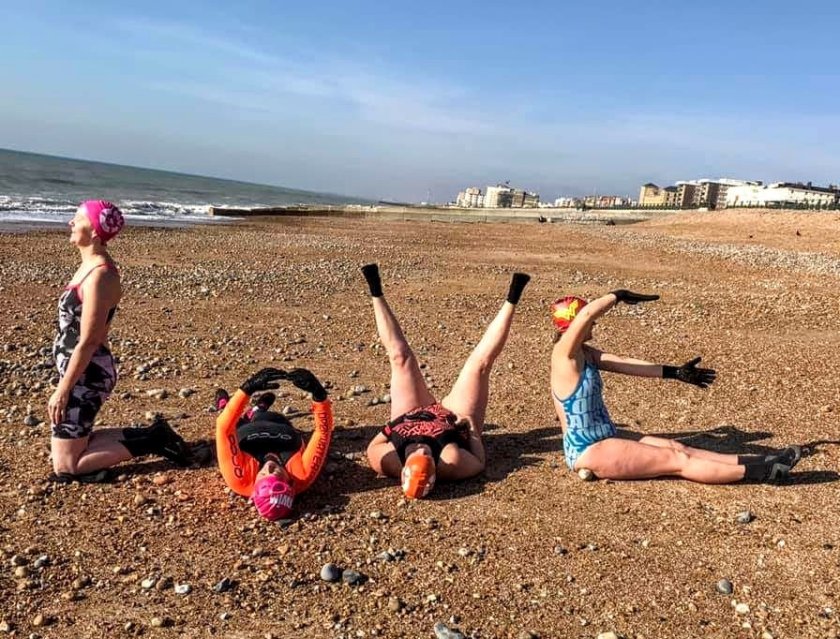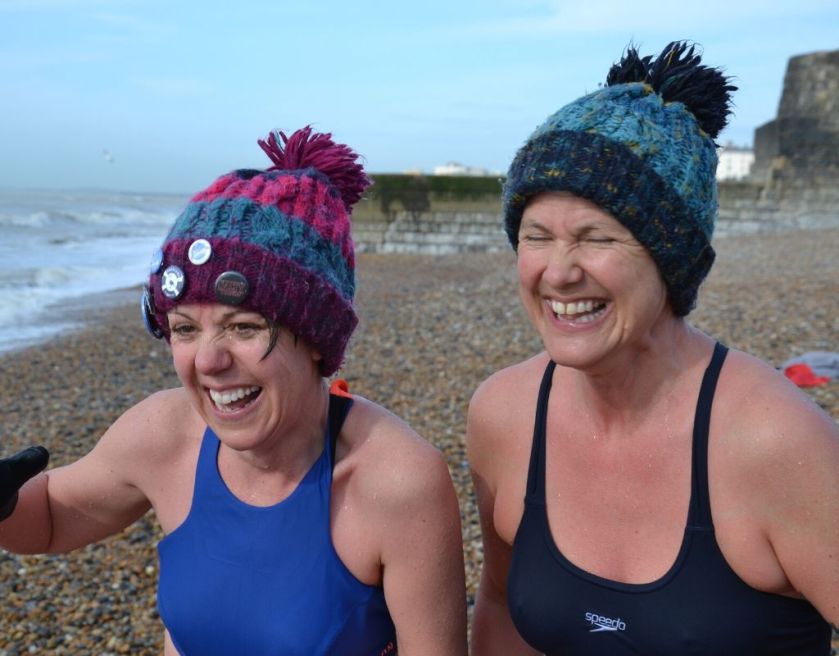There has been a lot of chatter in the Salty Seabird Community group as swimmers are gearing up for for cold water swimming. Many more swimmers are keen to join the flock as year round swimmers but need some pointers regarding kit, safety advice and tips on getting warm afterwards. So here goes;
What should you wear in the water?
That is entirely up to you. If you wear a wetsuit you will be able to go in the water for longer and be able to bear colder temperatures without the need for boots and gloves further into winter. You will also be able to swim with your head in the water longer into the season. Bear in mind that swimming wetsuits are designed for front crawl and can make your neck and shoulders ache if you are a head up breast stroke swimmer. You may wish to consider a standard watersports wetsuit instead which is more hard wearing and easier to get on without damaging. Oceans sports offer a discount for Seabirds. If you wish to skin swim (no wetsuit) all year round it is a good idea to wear neoprene accessories. Boots not only keep your feet warm but help you exit the cold water safely as the shingles move around with waves and hurt like hell as you try to walk back up to the beach to your warm clothes. Neoprene gloves keep your hands warm and able to function when it comes to fastening zips and negotiating getting dressed. A swim hat keeps the wind chill off your head and your hair dryish which also helps with staying warm. Thermal rash vests, neoprene rash vests and cossie are all options too.
For your safety we would recommend that you wear at least a bright coloured hat (RLSS and RNLI recommend orange or pink) and a tow float so you can be seen.

What should I wear whilst getting changed and after swimming?
Lots of loose layers – there is absolutely no need for underwear as you are likely to forget it anyway. We use Haramaki belly bands to warm up our cores and use as bras too. You can also pop a hot water bottle in there to warm up your kidneys. A woolly hat. We use bobble hats as a way to identify ourselves as Salty Seabirds. As soon as you whip off your neoprene or silicone swim hat – get a woolly one on. A Sports robe to get changed under whilst keeping the elements at bay. We particularly like the Charlie McLeod ones which now have version made out of PET but there are lots on the market to choose from. We like the Charlie because it is amply big to get changed in but not so big you can’t cycle in it etc. There short sleeved versions are the most popular. Woolly socks and cozy slip on boots are also recommended along with wrist warmers.

How can I warm up after swimming?
Have a hot drink of your choice. It you use an isothermal bottle to keep it in then poor into a mug to warm your hands. Sip it slowly and obviously accompany it with cake. Hot water bottles are great just be careful not to burn yourself as some have done in the past. You can wrap up your changing towel or clothes in it while you swim so they are warm when you get out. A mat to put down on the cold pebbles to stand on and keep the chill off your feet. Move around, whatever you do don’t sit still, or have a hot bath, or wrap in a blanket in front of a laptop. You need to warm up slowly using exercise. Walk the dog, do squats, run up and down the beach, do the hoovering. You need to warm up from the inside out, not the other way round. Your core and essential organs need to be warmed up slowly to prevent the after drop and hypothermia.
“After drop” is common after swimming in cold water; you get out and feel fine, and then you start to get colder, sometimes growing faint, shivering violently and feeling unwell.” (Outdoor Swimming Society)
Learning to head off the after drop is a key part of continuing to swim in cold water all year round. While in the cold water you can be lured into a false sense of security (numbness!) and stay in for what turns out to be too long. With practice you learn your limitations and just how cold you are going to be about 10 minutes after getting out. You then moderate your swim times and get out before you feel you have to. Then the key is warming up – slowly. If you have a hot shower, for example, the blood can run from your core (where it is working hard to maintain your core temperature and keep you alive!) to your skin and actually make your temperature drop along with your blood pressure – potentially making you feel faint and ‘stinging’ your skin.

How do I know if it is safe to swim?
Only you can answer this question. And if you are asking the question “is it safe to swim?” you are demonstrating uncertainty in your ability so the answer is probably no. It is unfair to ask your fellow swimmers to make this decision for you as only you really know you. Here is a checklist to go through but it is not exhaustive.
- Check the weather and sea forecast using Magic Seaweed, Wind Guru and Windy – this will give you a good indication but nothing beats taking a look yourself. Be prepared to change your mind/plans accordingly when you get to the beach. And during your swim.
- Consider your SEA swimming ability (not pool swimming ability). Are you an able and experienced year round sea swimmer that knows this beach well?
- Have you acclimatised throughout the season and do you know how to acclimatise and prevent cold water shock before each swim?
- How far, how long are you intending to swim for?
- Do you know how to get in and out of the sea safely and are there safe exit points?
- Are you physically well. No injuries, or infections or viruses that may impact your ability to swim and stay warm. Did you sleep well or are you tired.
- Are you mentally well or is your judgement impaired by tiredness, your state of mind of substances

How long should I stay in for?
No idea! That all depends on so many factors like what you wearing, how far you are swimming, what is the water temperature, your physical abilities, your seasonal acclimatisation. Again only you can make this decision. Experience will allow you to understand the messages your body is sending you so try to go regularly and build up slowly. Some get out when they start to feel comfortable and like they could stay in there forever. This is the stage your body enters prior to hypothermia so it’s good to get out before you become pre-hypothermic which can make you disorientated and shake uncontrollably. You’ll only do this once (we hope!).

What is the temperature of the water?
The answer to this will depend on who you ask, which forecast you use, what thermometer you use etc. A better question would be how cold will the water feel. So if the wind is northerly it will feel colder because the air temperature is colder. If it is the morning the pebbles won’t have had time to warm up making it much colder under foot. If it’s wavy with a south westerly wind it seems warmer somehow. If you are tired or if you haven’t eaten it will feel colder as you don’t have the resources to stay as warm. If you are just bobbing and chatting rather than swimming consistent strokes you will cool down quicker. So rather than how cold is the water you should be thinking how cold am I?

What else do I need to know?
Most of all have fun! Don’t take it too seriously. Wear a woolly hat and paddle if you need to earn the post swim cake. Find some other salty sea swimmers to share swims, laughter, loud swearing with. The Outdoor Swimming Society also has lots of useful blogs and articles to get you started.

Happy (cold) Swimming!
10 Best Bits of Cold Water Swimming Kit
- Woolly Hat and gloves, arm warmers. – it’s all about the layers
- Sports Robe – to keep the wind chill and rain off you while you change and protects your dignity on a public beach
- Haramaki core warmer – this is a game changer and warms up your vital organs fast and keeps the drafts out
- Changing Mat – keeps your feet warm and clean and you can wrap wet stuff in it.
- Neoprene gloves – keeps your hands warm to get dressed quickly
- Swim hat, cap or headband – you lose lose a significant an=mount of heat from your head
- Footwear – so you can get out of the cold sea quickly and safely
- Neoprene cossie or vest – keeps your core warm so you can stay in for a wee bit longer
- Flask of hot tea, coffee, chocolate or ribena
- CAKE – an lots of it – you have earned it!


Dear SeaBirds! I am a cold water sea swimmer newbie. Having enjoyed my first dip in Oslo fjord (-1C) last Saturday. I stumbled upon this page while looking for information about staying warm after swimming. This article provided an abundance of important information for swimmers taking the icy plundge. Not least all the fantastic women and happy smiles who are an inspiration! I wish I could join you all! Thank you for the great advice. All Best and warm hugs from Norway, Angela Amoroso
LikeLiked by 1 person
Oh thank you Angela – that is wonderful to hear!
LikeLiked by 1 person
Great Article about swimming, I get lots of knowledge about swimming which was really good. This page really has rich information.
LikeLiked by 1 person